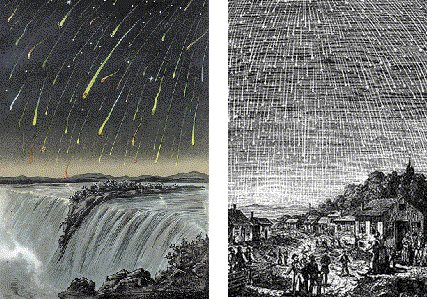November’s wonderful Leonid
meteor shower happens every year Around November 17 or 18, as our world crosses
the orbital path of Comet Tempel-Tuttle. Like many comets, Tempel-Tuttle
litters its orbit with bits of debris. It’s when this cometary debris enters
Earth’s atmosphere, and vaporizes, that we see the Leonid meteor shower.
In 2017, the peak night of
the shower is expected from midnight to dawn on Friday and Saturday mornings
(November 17 and 18). Best yet, there is no moon to intrude on the Leonid
meteor shower in 2017. Although this shower is known for its periodic storms,
no Leonid storm is expected this year.
How many Leonid meteors will
you see in 2017? The answer as always depends on when you watch, and the
clarity and darkness of your night sky. This shower has been known to produce
meteor storms, but no Leonid storm is expected this year. The Leonids are
usually a modest shower, with typical rates of about 10 to 15 meteors per hour
at the peak, in the darkness before dawn. The new moon on November 18
guarantees a dark sky for this year’s Leonid shower.
When should you watch for
Leonid meteors in 2017? Knowing what time to watch is easy. As with most meteor
showers, the best time to watch the Leonids is usually between the hours of
midnight and dawn. The expected peak morning is Friday, November 17 or Saturday,
November 18. That’s the mornings (not the evenings) of the November 17 and 18.
Where should you watch the
meteor shower? We hear lots of reports from people who see meteors from yards,
decks, streets and especially highways in and around cities. But the best place
to watch a meteor shower is always in the country. Just go far enough from town
that glittering stars, the same stars drowned by city lights, begin to pop into
view.
City, state and national
parks are often great places to watch meteor showers.
Try googling the name of
your state or city with the words City Park, state park or national park. Then,
be sure to go to the park early in the day and find a wide open area with a
good view of the sky in all directions.
When night falls, you’ll
probably be impatient to see meteors. But remember that the shower is best
after midnight. Catch a nap in early evening if you can. After midnight, lie
back comfortably and watch as best you can in all parts of the sky.
Sometimes friends like to
watch together, facing different directions. When somebody sees one, they can
call out meteor! Then everyone can quickly turn to get a glimpse.
Which direction should I
look to see the Leonids? Meteors in annual showers are named for the point in
our sky from which they appear to radiate.
This shower is named for the
constellation Leo the Lion, because these meteors radiate outward from the
vicinity of stars representing the Lion’s mane.
If you trace the paths of
Leonid meteors backward on the sky’s dome, they do seem to stream from near the
star Algieba in the constellation Leo. The point in the sky from which they
appear to radiate is called the radiant point. This radiant point is an optical
illusion. It’s like standing on railroad tracks and peering off into the
distance to see the tracks converge. The illusion of the radiant point is
caused by the fact that the meteors – much like the railroad tracks – are
moving on parallel paths.
In recent years, people have
gotten the mistaken idea that you must know the whereabouts of a meteor
shower’s radiant point in order to watch the meteor shower. You don’t need to.
The meteors often don’t become visible until they are 30 degrees or so from
their radiant point. They are streaking out from the radiant in all directions.
Thus the Leonid meteors –
like meteors in all annual showers – will appear in all parts of the sky. Will the Leonids produce a
meteor storm in 2017? No. Not this year.
 |
| Old woodcuts depicting 1833 Leonid meteor storm. |
Most astronomers say you
need more than 1,000 meteors an hour to consider a shower as a storm. That’s a
far cry from the 10 to 15 meteors per hour predicted for this year. Still,
seeing even one bright meteor can make your night.
The Leonid shower is known
for producing meteor storms, though. The parent comet – Tempel-Tuttle –
completes a single orbit around the sun about once every 33 years. It releases
fresh material every time it enters the inner solar system and approaches the
sun. Since the 19th century, skywatchers have watched for Leonid meteor storms
about every 33 years, beginning with the meteor storm of 1833, said to produce
more than 100,000 meteors an hour.
The next great Leonid storms
were seen about 33 years later, in 1866 and 1867. Then a meteor storm was
predicted for 1899, but did not materialize.
It wasn’t until 1966 that
the next spectacular Leonid storm was seen, this time over the Americas. In
1966, observers in the southwest United States reported seeing 40 to 50 meteors
per second (that’s 2,400 to 3,000 meteors per minute!) during a span of 15
minutes on the morning of November 17, 1966.
Via EarthSky




